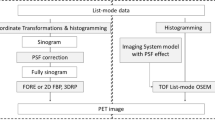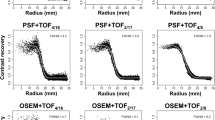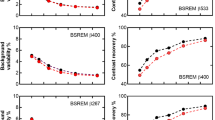Abstract
Objective
The aim of this study was to investigate the relationship between the NEC and TOF-PET image quality.
Methods
The National Electrical Manufactures Association and International Electrical Commission (NEMA IEC) body phantom with a 10-mm diameter sphere was filled with an 18F-FDG solution with a 4:1 radioactivity ratio. The PET data were acquired in the three-dimensional list mode for 20 min. We created frame data ranging from 1 to 5 min acquisition time, which were then reconstructed using the baseline ordered-subsets expectation maximization (OSEM), the OSEM + point spread function (PSF) algorithm, OSEM + time-of-flight (TOF) algorithm and OSEM + PSF + TOF algorithm. The PET images were analyzed according to the noise-equivalent count (NEC), the coefficients of variance of the background (CVBG), the maximum count (CVmax) and the contrast (CVCONT). The results were compared with the recommended value according to the guidelines for the oncology FDG-PET/CT protocol.
Results
The NEC was higher than the recommended value at 3 min or longer acquisition time. The CVBG lower than 15 % were obtained at 3 min acquisition time without TOF and at 2 min acquisition time with TOF. The CVBG of 10 % or lower were obtained at 5 min or longer acquisition time without TOF and at 4 min or longer acquisition time with TOF. Both the CVmax and CVCONT lower than 10 % were obtained at 3 min or longer acquisition time without TOF and at 1 min acquisition or longer with TOF. No particular relationships were observed between the frame number and degree of the variation in the image quality. The CVCONT significantly correlated with the NEC for the data reconstructed without TOF information, while there were no significant correlations between these useful metrics for the data reconstructed with TOF.
Conclusion
This study demonstrated that the NEC is not a useful metric for the evaluation of the image quality on TOF-PET images.




Similar content being viewed by others
References
Rohren E, Turkington T, Coleman R. Clinical applications of PET in oncology. Radiology. 2004;231:305–32.
Fischer B, Lassen U, Mortensen J, Mortensen J, Larsen S, Loft A, et al. Preoperative staging of lung cancer with combined PET-CT. N Engl J Med. 2009;361:32–9.
Hicks RJ, Kalff V, MacManus MP, Ware RE, McKenzie AF, Matthews JP, et al. The utility of (18)F-FDG PET for suspected recurrent non-small cell lung cancer after potentially curative therapy: impact on management and prognostic stratification. J Nucl Med. 2001;42(11):1605–13.
Beyer T, Townsend DW, Brun T, Kinahan PE, Charron M, Roddy R, et al. A combined PET/CT scanner for clinical oncology. J Nucl Med. 2000;41(8):1369–79.
Masuda Y, Kondo C, Matsuo Y, Uetani M, Kusakabe K. Comparison of imaging protocols for 18F-FDG PET/CT in overweight patients: optimizing scan duration versus administered dose. J Nucl Med. 2009;29:844–8.
Strother SC, Casey ME, Hoffman EJ. Measuring PET scanner sensitivity: relating count rates to image signal-to-noise ratios using noise equivalent counts. IEEE Trans Nucl Sci. 1990;37:783–8.
Watson CC. Count rate dependence of local signal-to-noise ratio in positron emission tomography. IEEE Trans Nucl Sci. 2004;51:2670–80.
Dahlbom M, Schiepers C, Czernin J. Comparison of noise equivalent count rates and image noise. IEEE Trans Nucl Sci. 2005;52:1386–90.
Fukukita H, Senda M, Terauchi T, Suzuki K, Daisaki H, Matsumoto K, et al. Japanese guideline for the oncology FDG-PET/CT data acquisition protocol: synopsis of version 1.0. Ann Nucl Med. 2010;24:325–34.
Tong S, Alessio AM, Kinahan PE. Noise and signal properties in PSF-based fully 3D PET image reconstruction: an experimental evaluation. Phys Med Biol. 2010;55:1453–73.
Surti S, Karp JS, Popescu LM, Daube-Witherspoon ME, Werner M. Investigation of time-of-flight benefit for fully 3-D PET. IEEE Trans Med Imaging. 2006;25:529–38.
Malti-Climent JM, Prieto E, Dominguez-Prado I, Garcia-Velloso MJ, Rodriguez-Fraile M, Arbizu J, et al. Contribution of time of flight and point spread function modeling to the performance characteristics of the PET/CT Biograph mCT scanner. Rev Esp Med Nucl Imagen Mol. 2013;32:13–21.
Akamatsu G, Ishikawa K, Mitsumoto K, Taniguchi T, Ohya N, Baba S, et al. Improvement in PET/CT Image quality with a combination of point-spread function and time-of-flight in relation to reconstruction parameters. J Nucl Med. 2012;53:1716–22.
Taniguchi T, Akamatsu G, Kasahara Y, Mitsumoto K, Baba S, Tsutsui Y, et al. Improvement in PET/CT image quality in overweight patients with PSF and TOF. Ann Nucl Med. 2015;29:71–7.
Watson CC, Casey ME, Bendriem B, Carney JP, Townsend DW, Eberl S, et al. Optimizing injected dose in clinical PET by accurately modeling the counting-rate response functions specific to individual patient scans. J Nucl Med. 2005;46:1825–34.
Brown C, Dempsey MF, Gillen G, Elliott AT. Investigation of 18F-FDG 3D mode PET image quality versus acquisition time. Nucl Med Commun. 2010;31:254–9.
Lois C, Jakoby BW, Long MJ, Hubner KF, Barker DW, Casey ME, et al. An assessment of the impact of incorporating time-of-flight information into clinical PET/CT imaging. J Nucl Med. 2010;51:237–45.
Conti M, Hong I, Michel C. Reconstruction of scattered and unscattered PET coincidences using TOF and energy information. Phys Med Biol. 2012;57:N307–17.
Vandenberghe S, Elmbt LV, Guerchaft M, Clementel E, Verhaeghe J, Bol A, et al. Optimization of time-of-flight reconstruction on Philips GEMINI TF. Eur J Nucl Med Mol Imaging. 2009;36:1994–2001.
Thielemans K, Asma E, Ahn Sm, RM Manjeshwar, T Deller, Ross SG, et al. Impact of PSF modeling on the convergence rate and edge behavior of EM images in PET. In: IEEE Nuclear Science Symposium Conference Record (NSS/MIC), Knoxville, TN; 2010. p. 3267–72.
Boellaard R, Krak NC, Hoekstra OS, Lammertsma AA. Effects of noise, image resolution, and ROI definition on the accuracy of standard uptake values: a simulation study. J Nucl Med. 2004;45:1519–27.
Lodge MA, Chaudhry MA, Wahl RL. Noise considerations for PET quantification using maximum and peak standardized uptake value. J Nucl Med. 2012;53(7):1041–7.
Schwartz J, Humm JL, Gonen M, Kalaigian H, Schoder H, Larson SM, et al. Repeatability of SUV measurements in serial PET. Med Phys. 2011;38:2629–38.
Karp JS, Surti S, Daube-Witherspoon ME, Muehllehner G. Benefit of time-of-flight in PET: experimental and clinical results. J Nucl Med. 2008;49:462–70.
Molina-Duran F, Dinter D, Schoenahl F, Shoenberg SO, Glatting G. Dependence of image quality on acquisition time for the PET/CT Biograph mCT. Z Med Phys. 2014;24:73–9.
Mullani NA, Markham J, Ter-Pogossian MM. Feasibility of time-of-flight reconstruction in positron emission tomography. J Nucl Med. 1980;21:1095–7.
Budinger TF. Time-of-flight positron emission tomography: status relative to conventional PET. J Nucl Med. 1983;24:73–8.
Conti M. Effect of randoms on signal-to-noise ratio in TOF PET. IEEE Trans Nucl Sci. 2006;53:1188–93.
Author information
Authors and Affiliations
Corresponding author
Ethics declarations
Conflict of interest
No potential conflict of interest was disclosed.
Rights and permissions
About this article
Cite this article
Maebatake, A., Akamatsu, G., Miwa, K. et al. Relationship between the image quality and noise-equivalent count in time-of-flight positron emission tomography. Ann Nucl Med 30, 68–74 (2016). https://doi.org/10.1007/s12149-015-1032-0
Received:
Accepted:
Published:
Issue Date:
DOI: https://doi.org/10.1007/s12149-015-1032-0




